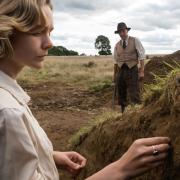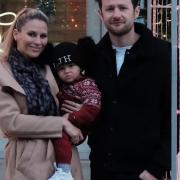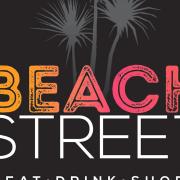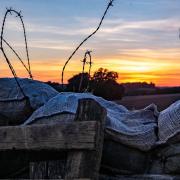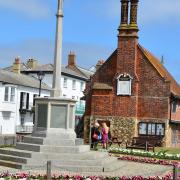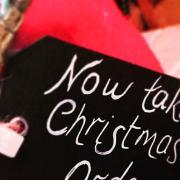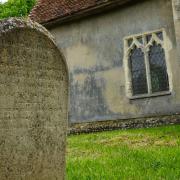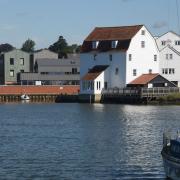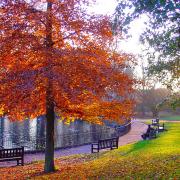Liz Sayers, a former editor of the town's weekly newspaper, examines the parts of Newmarket often overlooked by visitors
Liz Sayers, a former editor of the town's weekly newspaper, examines the parts of Newmarket often overlooked by visitors
For most market towns, a royal visit is a ‘once in a lifetime’ occasion. Not so in Newmarket where the Queen has been a frequent official and unofficial For most market towns, a royal visit is a ‘once in a lifetime’ occasion. Not so in Newmarket where the Queen has been a frequent official and unofficial visitor since her childhood.
Royal patronage of Newmarket dates back to the 17th century and the town has continued to maintain an attitude of affectionate familiarity with the monarch of the day.
Coming only four days after THE WEDDING, the most recent Royal visit was to mark the 13th anniversary of Newmarket Day Centre, the charity that has transformed retirement into the ‘time of their lives’ for so many of the town’s pensioners over the past three decades.
The day centre stands on Fred Archer Way, named after the 19th century’s most successful jockey who rode in more than 8,000 races and won 2,748 of them, including many classics, and was undoubtedly the greatest jockey of his day and arguably of all time.
Lester Piggott Way and Willie Snaith Road honour two of the 20th century’s royal jockeys. Willie, affectionately dubbed the Pocket Hercules by racegoers in his heyday in the 1950s, was one of the first ‘racing names’ signed up to conduct guided tours of Newmarket in the 1980s.That was the time the ‘Home of Horseracing’, began to embrace the tourism opportunities open to a town with two racecourses, 2,500 horses in training at 70 stable yards and 50 of the most important thoroughbred stud farms in the surrounding countryside.
Apart from those directly employed in stables, on the stud farms or maintaining the training grounds and racecourses, a huge proportion of the 15,000 inhabitants owe their livelihood, directly or indirectly, to the thoroughbred. As well as farriers, saddlers and feed merchants there are more than 100 veterinary surgeons working in the town providing 24-hour care 365 days a year to Newmarket’s equine population.
The National Horseracing Museum in the High Street, opened by the Queen in 1983, tells the story of racing – the people, the horses and the history – through the permanent collections and this year’s special exhibition, The Heath and the Horse. If you want to understand what it feels like to be a jockey, there’s the chance to dress up in racing silks and ride a horse simulator under the watchful eye of a retired jockey.
The walls of the museum cafe are gradually being covered by Jacquie Jones’s paintings of racing personalities. She’s been the museum’s artist in residence since 1997. Linger over lunch – the home-cooked food is great – and see how many jockeys, trainers and racing pundits you can identify.
The museum also offers tours to watch horses in training on the Heath, visits to stables, the equine swimming pool and the National Stud. The Rowley Mile racecourse, named after Charles II’s horse, Old Rowley, hosts racing in the spring and autumn, including the first classics of the year, the 1000 and 2000 Guineas in May, which like the historic Cambridgeshire and Champions meetings in October, are watched – and bet on – by millions around the world.
Look at a map and you’ll see Newmarket sits in a Suffolk ‘bubble’. Drive out of the town to the racecourse that stages summertime meetings and you will cross the county boundary into Cambridgeshire.
The July Course has had a makeover and, post-renovations, can claim to host the most glamorous sporting event in the East of England, the Newmarket July Festival, with a Ladies’ Day to rival Royal Ascot’s. The July Course is also home to Newmarket Nights when Friday evening racing is followed by an open-air concert. This year’s line-up includes Jools Holland, James Blunt, Scissor Sisters, Boyzone, Tom Jones and Peter Andre.
However, though thousands flock to watch racing, and hotel rooms are also at a premium during thoroughbred sales at Tattersalls Sales Ring, the best efforts of the Tourist Information Centre, which has devised the ‘Newmarket Horseshoe Trail’, tourists are less in evidence than they are in neighbouring towns like Ely, or Bury St Edmunds.
Although Newmarket can’t boast a cathedral, the official tourist trail maps out 27 buildings of historic interest, starting at Palace House, believed to be an extension of the palace that was built for King Charles II in the mid 1600s.
Others on the trail include the dress shop on Rutland Hill which was originally built as a theatre in 1839, later becoming the town hall and then a cinema. Its cellar is believed to even older and housed one of the cock pits frequented by Charles II, who might also have watched cock fights at The Bushel pub whose cellar also bears traces of a cock pit. The Bushel, one of the town’s oldest pubs, is one of the few buildings to survive a fire in 1683 which destroyed almost all of the north side of the High Street. You’ll find it at the end of pedestrianised Market Street, at the entrance to the shopping centre originally called The Rookery – the names means ‘crowded cluster of mean houses and tenements’ – which was an apt description of the derelict area before it was redeveloped in the late 1960s.
Terry Wogan, then a little-known radio presenter, opened Budgen’s, the first major chain to move into The Rookery – the site was later acquired by Marks and Spencer – and the shopping centre has recently been re-named The Guineas but my guess is that we’ll all continue to call it The Rookery.
Opposite M & S is Tennant’s, purveyors of Musk’s ‘Newmarket sausages’. Round the corner in Wellington Street is Powter’s pork shop whose ‘Newmarket sausages’ are made to a slightly different, but equally secret, recipe. If you want to take home a taste of Suffolk, buy a few pounds of Newmarket sausages and see which ones best tickle your taste buds. Both butchers have recently got together to apply for Protected Geographical Status for their bangers so that Newmarket sausages might benefit in the same way as Stilton cheese and Parma ham.
As construction continued on The Rookery site, demolition robbed the High Street of its most flamboyant example of Victorian architecture – the Carlton Hotel. A decade or so later, what had been the Doric Cinema which boasted a stage as large as the London Palladium’s, became the Cabaret Club, the first of the ventures which have turned Newmarket into something of a regional nightclub capital.
On the opposite side of the street, where small boys once enjoyed Saturday morning cowboy films and where 500 would queue on Sunday evenings to listen to bluegrass and country music at England’s Grand Ole Opry in the 70s and 80s, the old Kingsway Cinema is now home to clubs aimed at a very different clientele.
While other towns complain about the number of estate agents and charity shops, recent letters to the editor of the Newmarket Journal have grumbled about the number of bookmakers. But if you don’t fancy a flutter, the town still has plenty of independent retailers to tempt you to open your wallet.
Michael Wigg is still behind the counter in the family jewellers – look out for a section of his window display where you’ll often see exquisite pieces of Victorian and Edwardian broaches, tie pins and trinkets with an equine motif – and although Peter Golding was the last member of his family to preside over the shop that still bears his family name, another Suffolk family has bought the business and continues to stock the tweeds and twills worn by the best dressed trainers in town.
Turn off the High Street and walk down Sun Lane where you’ll find a delicatessen, a china shop, paint-it-yourself pottery shop and a quality second-hand clothes shop which is a happy hunting-ground for designer labels at bargain prices.
Newmarket’s best known landmark is the Clock Tower, built to commemorate Queen Victoria’s Diamond Jubilee in 1897. Next year as we celebrate her great-great-granddaughter’s own Diamond Jubilee surely the town will find a suitable way to pay its own tribute to a monarch whose love and support of racing has done so much to ensure Newmarket prospers into the 21st century.



